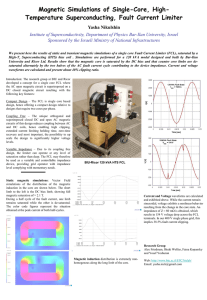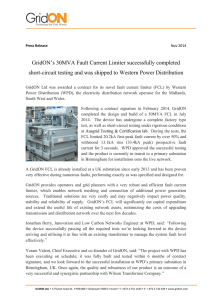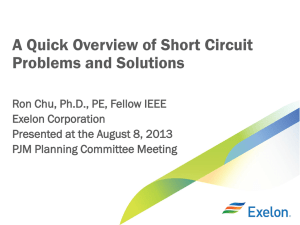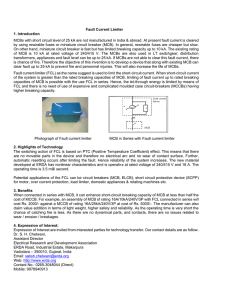Fault Current Limiters - Center for Advanced Power Systems
advertisement
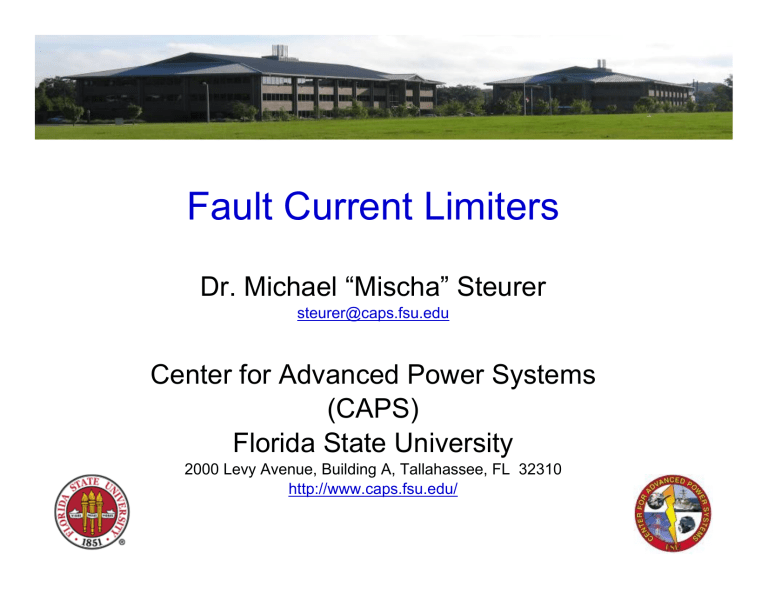
Fault Current Limiters Dr. Michael “Mischa” Steurer steurer@caps.fsu.edu Center for Advanced Power Systems (CAPS) Florida State University 2000 Levy Avenue, Building A, Tallahassee, FL 32310 http://www.caps.fsu.edu/ Outlook • What’s a short circuit? • How does a FCL work? • What are the applications? • What FCL technologies exist? • What are the system integration issues? • Where to learn more? 2 Short Circuits Are Unavoidable 3 Fault Currents • RSource Breach of “voltage” V Source insulation causes short circuits • Short circuits lead to excessively large currents • Protective relays detect the large current and trip a circuit breaker CB (or a fuse blows) Fault occurs • Large number of faults clear after CB interruption (tree Normal load branch breaks, current ILoad squirrels die, overhead conductors part touched) LSource ILoad Circuit Breaker 20...50 times ILoad IFault RLoad Circuit Breaker interrupts 4 Fault Currents: Thermal Effects Thermal energy at fault location tF WF i v F dt 0 v F const . WF i Source: Bonneville Power Administration, USA 5 Fault Currents: Mechanical Effects Source: http://www.gaiengineers.com/photos.htm Mechanical force between two wires 0 l I1 I 2 F 2 a I1 I2 l a 6 Different Types of SCFCLs Resistive Type (Pure Resistive) Operation Modes Short-circuit Limiter Recovery Rp Without limiter Current iac RQ Switch LQ RSC=0 Load Normal op. Electrical Circuit U0 iac Time 7 Different Types of SCFCLs Resistive Type (Pure Resistive) Operation Modes Short-circuit Current Without limiter Limiter Recovery Rp iac RQ Switch LQ RSC>0 Load Normal op. Electrical Circuit U0 iac Time 8 Different types of SCFCLs Resistive Type (Pure Resistive) Operation Modes Short-circuit Current Without limiter Limiter Recovery Rp iac RQ Switch LQ RSC→0 Load Normal op. Electrical Circuit U0 iac Time 9 Why FCLs? Compromise in Power Systems Normal Normal Operation: Operation: High High short-circuit short-circuit capacity capacity (low (low short-circuit short-circuit impedance) impedance) Fault Fault Condition: Condition: Low Low short-circuit short-circuit capacity capacity (high (high short-circuit short-circuit impedance) impedance) •• •• Low Low voltage voltage drop drop (high (high power power quality) quality) High High steady-state steady-state and and transient transient stability stability •• •• •• Low Low system system pertubations pertubations •• •• •• Low Low thermal thermal and and mechanical mechanical strain strain Reduced Reduced breaker breaker capacity capacity Optimal Optimal Solution: Solution: FCL FCL Low Low impedance impedance during during normal normal operation operation Fast Fast and and effective effective current current limitation limitation Automatic Automatic and and fast fast recovery recovery 10 Measures To Limit Short-Circuit Currents Permanent Permanent increase increase of of impedance impedance at at nominal nominal and and fault fault conditions conditions Condition Condition based based increase increase of of impedance impedance Small Small impedance impedance at at nominal nominal load load fast fast increase increase of of impedance impedance at at fault fault Old term: “passive” • Splitting into sub grids • Introducing a higher voltage range • Splitting of bus bars Old term: “active” • High impedance transformers • High voltage fuses (< 1 kA, < 36 kV) • Current limiting air core reactors • IS-limiter (< 4 kA, < 36 kV) • FCL circuit breakers (< 1 kV) Novel Concepts • Superconductors • Semiconductors e.g. FACTS • Hybrid systems Sequential tripping Topological Topological measures measures Apparatus Apparatus measures measures Source: ”Survey of Fault Current Limiter (FCL) Technologies”, EPRI, Palo Alto, CA: 2005, 1010760 11 FCL Applications 1 FCL FCL 1 Generator feeder 2 2 Power station auxiliaries 3 Network coupling Transmission network 4,5 Busbar coupling SC-Cable FCL Distribution network 3 FCL 9 9 6 Shunting current limiting reactor FCL 7 Transformer feeder Distribution network Distribution network 8 Busbar connection 9 Combination with other SC devices, especially SC cables 4 FCL 10 Coupling local generating units FCL 5 FCL 11 Closing ring circuits 10 6 FCL FCL 7 FCL FCL 8 11 Source Noe, M.; Oswald, B.R., “Technical and economical benefits of superconducting fault current limiters in power systems”, IEEE Trans. Appl. Supercon. Vol. 9/2, June 1999, pp. 1347 –1350 12 Potential SCFCL Applications Favorite SCFCL Applications • •above 145 kV • 2% Up to 145 kV • 11% up to 145 kV • 11% • • Above 145 kV 2% up to 36 kV 87% Up to 36 kV 87% Source: Fault Current Limiters Report on the Activities of CIGRE WG 13.10 by CIGRE Working Group 13.10 (*), CIGRE Session 2004, Paris 13 DOE’s FCL initiative June 27, 2007 DOE Provides up to $51.8 Million to Modernize the U.S. Electric Grid System Superconductor Research Crucial to Improving Power Delivery Equipment FAULT CURRENT LIMITERS American Superconductor - (DOE cost share: $12.7 million) The team also includes: Nexans (France), the University of Houston (Houston, TX), Los Alamos National Laboratory (Los Alamos, NM), and Siemens AG (Germany). Zenergy Power (formerly SC Power Systems) - (DOE cost share: $11 million) SC Power’s team includes: DOE’s Los Alamos National Laboratory (Los Alamos, NM); Air Products and Chemicals Inc. (Allentown, PA); Cryo-Industries of America Inc. (Manchester, NH); Consolidated Edison Company (New York, NY); California Edison Inc. (Rosemead, CA); Delta Star Inc. (San Carlos, CA); and Trithor GmbH (Germany). http://www.oe.energy.gov/fcl.htm SuperPower Inc. - (DOE cost share: $5.8 million) SuperPower’s team includes: Sumitomo Electric Industries Ltd. (Osaka, Japan); Nissan Electric Co. Ltd. (Kyoto, Japan); The BOC Group Inc. (Murray Hill, NJ); American Electric Power (Gahanna, OH); and DOE’s Oak Ridge National Laboratory (Oak Ridge, TN). 14 SCFCL Field Tests ABB World wide first field test of a SCFCL At hydro power station Löntsch, Switzerland (1996) Shielded core type SCFCL Main data: Voltage 10 kV Current 70 A Temperature 77 K BSCCO2212 tubes Scheme Iron core LN2 Superconductor Copper winding Cryostat Courtesy ABB 15 SCFCL Field Tests CURL10 World wide first resistive SCFCL field test at RWE, Germany (field test April 2004-March 2005) Demonstrator application in a 10 kV busbar coupling 110 kV 15 MVA Sk = 125 MVA uk = 12,5 % Main data: Voltage 12 kV Current 600 A Lim. time 60 ms Max. current 8.75 kA Temperature 65 K Max. E-field 0.6 V/cm MCP-BSCCO2212 bifilar coils FCL 10 kV pulsating loads grid interference Photo: ACCEL, Germany 16 Solid State FCL • No cryogenics • Immediate recovery • Fail safe • No current distortions • SuperGTO • Lower losses • Reduced size and weight SGTO-based Power Processor 7’ 5’ 9’ • 15kV, 1200A RMS • Power stack = 108” (w) x 60” (d) x 84” (h) 17 Saturated Iron Core FCL RL M W -V2 _0 Man i. 12 0 Vs V Man i. MW -V 2_0 MW -ph2 _0 90 60 .0 12 0 0 F RRL Phase Ph -90 SHA NDIN 15 11 -2kV Fre q de g V k 11 5 M W -p2 h_0 P==-05.3.5238 Q 95 V=120 A V P_ Sou rc e Q_ Soruc e Q_ Sou rc e _Soruc V e _Sou V rc e Tm i ed _CB1 Breae L kr Log ic Co l se d@ t0 Tm i ed _CB3 Brea L ker Lg oci Co l sed@ t0 Tm i ed _CB4 Breaker L Log ic Co l se d@ t0 P_ Soruc e O1 S47 8 0.00 1[u F] #1 A V 2 #3 # 2 #3 # #1 00 .0 1[u F] 2 #3 # P=03 .91 Q=01 .95 V=10 .3 2 M P E2 34 9 0.00 1[u F] _CB4 L #1 _CB1 L _CB3 L Man i. CA PSW -0 0 .00 676M [W ] 12 .9 7[M AR] V RCI1 44 9 P=0 .5 302 Q=0.1 735 V=10 .37 CAP SW P=0 .2 317 Q=0 .6 102 V=10 .33 A V . 2M 1 [VA R] PM H3 431 A OAD2 V L bus107 03 .6[M W ]01 .83M [V AR] CAPS W 03 .[M W ] 01 .5M [VA R] P=03 .1 23 Q=01 .0 61 V=1 .3 02 P=03 .20 9 Q=0 .6 1 V=10 .3 2 A V A V 0 COUPL ED PI SE CTION GS 426 9 Sha nd i O 18 ,8 0' 70 5XL P .2 0 3[M W ] 0 .6 1[M VAR] 03 .0[M W ]01 .5[M VAR] su b2 1kV Main SW C GS 15 47 W S SW GS5 13 FI15 V 44 0 SW COUP LED PI SECT IN O Ia4 Ia4 Ib4 Ib4 RM S P=.53 53 Q=-03 .88 2 V=10 .44 A V in L e Ava nti 12kV ,10 20A FCL oad L 41 3' 100L XP Ia 4_RM S CO UPLED PI SE CTION PI SECT ION PI SE CTION 64 ,5 1' 100XL P 64 ,15 ' 100XL P RM S ,3 3 68' 100 0 XLP A V J9 88 OUPLE C D COUPLE D COU PLED I P SCTION E I P SCTION E PI SEC TION 20 ,31 ' 1000 XLP 20 ,2 7' 100L XP 51 ,0 6' 100L XP P=0.356 3 Q=0.178 4 V=1.09 3 Ib4_ RMS fau lt Ic4 A V P=47 .8 6 Q=-08 .14 1 V=.13 07 P=38 .22 Q=-1.30 3 V=10 .3 A V COU PLED PI SE CTION P=.5 3 Q=1 -.43 6 V=10 .3 P=30 .1 8 Q=-1 .0 73 V=.13 03 A V A V 10' 0 00X 1 0LP CO UPLED COUPL ED PI SE CTION PI SECITN O 90' 0 000 1 XLP 14 ,8 4' 100XL P P=07 .2 85 Q=03 .9 86 V=.0 132 P=0 .9 311 Q=0 .9 146 V=10 .32 COUPL ED A V A V PI SECTION P=03 .91 3 Q=01 .95 1 V=.13 02 11 ,9 0' 100L XP A V Ia4_ RMS Ib 4_RM S Man i. Ic4 P=51 .3 7 Q=-0 .4 607 V=.13 07 Ic 4_RM S O C Ic4 _RMS fau lt P=0 Q=0 V=0 fautl A V P=0.35 49 Q=0.179 1 V=1 .3 04 P=0 .9 518 Q=0 .8 291 V=10 .3 A V A V 03 .6[M W ]0.13 8[M AR] V A V 0 03 .2M [W ] 01 .6M [V AR] 0.55[M W ] 02 .7[M VA R] 03 .2M [W ]0.16[M VA R] Ifa2 Tm i ed Fau lt BC->G Log A i c Ifb2 Ifb2 Ifc2 Ifc2 RMS RMS P=03 .1 27 Q=01 .0 62 =10 V .33 A V If2 a_RMS Ifa2_ RM S .2 0 3[M W ]0 .6 1[MV AR] If2 b_RMS .0 0 3[M W] 0 .5 1M [ VA R] Ifc2 _RM S LOTS P ZPPo l ts_ PHAS E_AL RMS If2 c_RM S Ifc2 _RM S Tested@G ridVotlage=120kVwtihreducedcircuit M odifiedFaultO NR ESS I TAN CE=0.01OH M P0 =3 .912 Q=.09 151 V=10 .3 2 A V 40 E 219 6 P=0.1 608 Q=00 .0 81 V=10 .33 S13 B 89 CAP SW 2 -0 0 .9 001 9[M W ] .1 1 98[M VA R] Ma in CAPS W 2 APSW C 2 03 .66M [W ]01 .83M [VA R] O 0 1.8[M VAR] A V sw4 Ma i n. .5 0 1[M W]0 .7 05[M VAR ] w4 s O PS2 06 2 36AC SR 65 4' 36 3ACSR-M lug tiroud ned CO UPLED PI SE CTION 48' 5 100 0 XLP P=15 .8 3 Q=1 -1 .38 V=1 .3 02 A V COUP LED PI SEC TION 13 ,4 2' 100L XP RC I15 43 P=.18 53 Q=1 -1 .3 8 V=1.032 0 A V w4 s CO UPLED PI SE CTION 00' 1 100 0 XLP P=15 .82 Q-1 =1 .3 8 V=10 .3 2 P0 =4 .047 Q=1 -7 .2 3 V=10 .3 2 A V A V P0 =3 .955 Q=.09 151 V=10 .3 2 CO UPLED A V PI SE CTION 20' 100L XP P=07 .6 85 Q=03 .9 81 V=1 .3 02 03 .7[M W ]0.183M [VA R] A V OUPLE C D 12 kV 800 A 23 kA rms 20% 30 cycles Instantaneous CS136 R 5 PIO IN SEC T 10' 35 0XLP Voltage: Current: Prospective Fault: Fault Reduction: Fault Duration: Recovery Time: S15 G 46 COUPL ED 91' 5 100L 0 XP Ifa2 Specifications: GS14 55 COU PLED fautl Southern California Edison, USA Energized 9 March 2009 RM S 0.3[M 0W ]01 .5[M VA R] CS1 R 08 18 Saturated Iron Core FCL Requirements: Voltage: Current: Prospective Fault: Fault Reduction: Fault Duration: Recovery Time: American Electric Power, USA Energization early 2012 FCL 138 kV 1300 A 20 kA rms 43% 5 cycles x 5 shots Instantaneous FCL – 345 kV /138 kV Feeder application 19 Saturated Iron Core FCL Present Future Benefit – replace conventional reactor with FCL and reduce steady state voltage drop by 75% 20 Issues Around FCL Integration • FCL characteristics introduce new system dynamics – Validated models for system simulation studies needed – Standard testing procedures must be developed – System protection must be investigated • How to coordinate FCL characteristic with existing protection schemes? • New protection schemes are possible with FCL for future systems • Cryogenics (for SCFCL) – Utilities are not used to cryo systems – Coordination with other demonstration projects (SC-cables, SCtransformer, SC-condenser) can yield to mutual benefits regarding acceptance 21 Impact of FCL on Protection Systems Fault With FCL In Front of Re lay (50% Line Le ngth) 3 • Slowing of fault clearing governed by inverse-time characteristics of conventional protection schemes • False readings of impedance relays upstream of the FCL location • Effects of non-sinusoidal fault currents • Simplifying the sometimes complex existing schemes which are to overcome circuit breaker limits FCL in upstream of PTs and CTs => Distance relay does not trip 2 Trip 1 Current 0 (kA) Relay State Normal -1 Total S upe rconductor S hunt trip -2 -3 0.14 0.15 0.16 0.17 t (s ) 0.18 0.19 0.2 22 FCL Working Groups • CIGRE brochure 239 “FAULT CURRENT LIMITERS IN ELECTRICAL MEDIUM AND HIGH VOLTAGE SYSTEMS” • CIGRE brochure 339 “GUIDELINE ON THE IMPACTS OF FAULT CURRENT IMITING DEVICES ON PROTECTION SYSTEMS” • CIGRE WG A3.23 “Application and feasibility of Fault Current Limiters in Power Systems” • IEEE WG PC37.302 “Guide for Fault Current Limiter Testing” ramp approx . 100 ns ramp approx. 100 ns 23 23 kVpeak kV peak µs/div 11 µs/ div 6.7 6.7 kV/ div kV/div lightning impulse set - up 75 kV BIL test of CURL10 device 23 Concluding Remarks • Fault Current Limiters (FCL) are emerging Smart Grid technologies – Facilitate cost effective increase in power transmission capacitances – Reduce impact of disturbances – Increase equipment life 24
